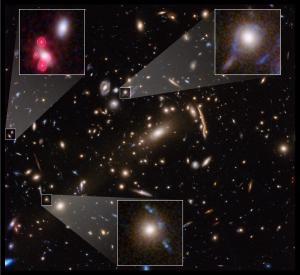Blog
Huddled in the Dark
14 September 2020
Dark matter is difficult for astronomers to study, but that doesn’t keep them from trying. And with skill and determination, they continue to find exciting things about the invisible stuff.
Because dark matter doesn’t emit or absorb light, there are only a few ways to determine how dark matter is distributed throughout the cosmos. One way is to look at the grouping of galaxies into superclusters. The idea is that since dark matter exerts a gravitational pull on nearby matter, galaxies will tend to be where dark matter is most plentiful. The clustering we observe is in general agreement with dark matter models.
Another way to study dark matter is to see how it causes light to bend. Light is often seen to gravitationally lens around galaxies and galaxy clusters. By measuring where the lensing of light occurs, we can get a rough idea of how dark matter is clustered. From this, we think that dark matter tends to be broadly distributed within galaxy clusters. But a new study of gravitational lensing has given us a few surprises.1
 NASA, ESA, P. Natarajan, G. Caminha, M. Meneghetti, and the CLASH-VLT/Zooming teams
NASA, ESA, P. Natarajan, G. Caminha, M. Meneghetti, and the CLASH-VLT/Zooming teamsindividual galaxies.
Recently a team used observations from the Hubble Space Telescope and the Very Large Telescope. By combining data, they were able to make high-resolution gravitational lensing maps of a few galaxy clusters. They found the overall lensing effects we’ve seen before, but they also found strong lensing effects around several individual galaxies within the clusters.
This means that dark matter must be densely clustered within individual galaxies since only dense dark matter can create a strong gravitational lens. In other words, dark matter seems to clump much more strongly than we’ve thought.
We aren’t entirely sure why this strong clustering of dark matter occurs, but it does rule out some dark matter theories. We’ve known, for example, that dark matter must be mostly “cold,” meaning that individual dark matter particles can’t be moving through space at high speeds. This is one of the reasons we know that neutrinos can’t make up dark matter. While neutrinos don’t interact strongly with light and are, therefore, a form of “dark” matter, neutrinos are “hot” because they move at a large fraction of light’s speed. Hot dark matter doesn’t form the type of clumps we see in dark matter.
To form the kind of dense clumps seen in this new result, at least some dark matter must be quite cold. The big question is how it could get so cold. One idea is that dark matter interacts with itself. When dark matter is clumped together by gravity, dark matter particles can collide in a way that releases energy, thus cooling dark matter. We see this kind of cooling in regular matter, but ordinary matter does this by releasing light energy.
Some dark matter theories propose a form of dark matter that can also release light when interacting. But so far, studies that have searched for such emitted light have come up empty.
Like many dark matter studies, this new work both answers and raises questions about dark matter. The team hopes that future studies will further narrow down the range of possible theories, but we remain a bit in the dark until then.
Massimo Meneghetti, et al. “An excess of small-scale gravitational lenses observed in galaxy clusters.” Science Vol. 369, no. 6509, (2020). ↩︎